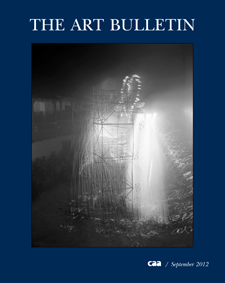CAA News Today
September 2012 Issue of The Art Bulletin
posted Sep 10, 2012
 The September 2012 issue of The Art Bulletin, the leading publication of international art-historical scholarship, presents the third installment of its new feature series that will continue for two more volume years. In Regarding Art and Art History, Richard Shiff analyzes the role of interpretation in writing about art through the prism of Meyer Schapiro and Clement Greenberg’s different approaches to the topic. The subject of this issue’s Notes from the Field is contingency, with texts by eleven artists, scholars, professors, and philosophers: Linda Connor, Giovanna Borradori, Marcia Brennan, Mary Ann Doane, Angus Fletcher, Peter Geimer, Gloria Kury, Mark Ledbury, C. Brian Rose, Frances Spalding, and Chris Spring. A photograph based on Connor’s 2010 film Fireworks for the Virgin, shot in Peru, appears on the cover.
The September 2012 issue of The Art Bulletin, the leading publication of international art-historical scholarship, presents the third installment of its new feature series that will continue for two more volume years. In Regarding Art and Art History, Richard Shiff analyzes the role of interpretation in writing about art through the prism of Meyer Schapiro and Clement Greenberg’s different approaches to the topic. The subject of this issue’s Notes from the Field is contingency, with texts by eleven artists, scholars, professors, and philosophers: Linda Connor, Giovanna Borradori, Marcia Brennan, Mary Ann Doane, Angus Fletcher, Peter Geimer, Gloria Kury, Mark Ledbury, C. Brian Rose, Frances Spalding, and Chris Spring. A photograph based on Connor’s 2010 film Fireworks for the Virgin, shot in Peru, appears on the cover.
In the issue’s Interview, James Ackerman converses with Cammy Brothers about how recent trips to Turkey, Egypt, and India have affected his outlook on teaching architectural history. Ackerman, editor of The Art Bulletin from 1956 to 1959, also describes his formative years as a student at Yale University and his teaching career at Harvard University.
The September issue also features four essays that cover a wide range of art-historical topics and time periods. Jaś Elsner explores a transformative moment in the eighth century, when the icon was considered entirely as representation, and analyzes the debates that precipitated this moment among Christians, Jews, Muslims, and pagans. In her essay “Francesco Rosselli’s Lost View of Rome: An Urban Icon and Its Progeny,” Jessica Maier reconstructs Rosselli’s monumental engraving of Rome and analyzes the work as a marker of high innovation in Renaissance print culture. Elizabeth Kindall discusses how the seventeenth-century Chinese artist Huang Xiangjian moved to an experiential reading of the handscroll format and how this shift from a traditional, linear reading culminated in a panoramic “grand view.” In his essay “Architecture and Crime: Adolf Loos and the Culture of the ‘Case,’” Frederic J. Schwartz takes a close look at two widely publicized trials involving the modern Viennese architect Adolf Loos, demonstrating the implications of these encounters with criminality for Loos’s architecture practice and theory and their importance in the wider public sphere.
The books under review in this issue represent a broad cross-section of art-historical scholarship. Philippe Morel assesses Alessandro Nova’s The Book of the Wind: The Representation of the Invisible, and Carl Brandon Strehlke reviews eight books published within the last seven years on the Italian Renaissance painter Giotto. Ariella Azoulay looks at Martin A. Berger’s Seeing through Race: A Reinterpretation of Civil Rights Photography. Finally, Matthew Simms reviews two new volumes on Willem de Kooning, Richard Shiff’s Between Sense and de Kooning and the catalogue for the Museum of Modern Art’s 2011 retrospective of the artist, edited by John Elderfield, the exhibition’s curator.
CAA sends The Art Bulletin to all institutional members and to those individuals who choose to receive the journal as a benefit of their membership. The next issue of The Art Bulletin, to be published in December 2012, will feature Rebecca Zorach’s reflections on politics and teaching in Regarding Art and Art History, the texts collected in Notes from the Field will be on the topic of detail, and the Interview will feature a conversation between the German art historian Horst Bredekamp and Christopher Wood. The long-form essays include a new interpretation of the Judgment of Paris myth as it is depicted in Roman wall paintings; a close reading of the Italian Renaissance sculptor Filarete’s Hilaritas, a bronze relief on the doors of Saint Peter’s Basilica in the Vatican; a consideration of Caravaggio’s signature in Beheading of Saint John the Baptist; an analysis of a Central American painting from the mid-1680s; and an exploration of the unpublished papers of the nineteenth-century English connoisseur George Scharf. The Reviews section will include analyses of books on Islamic museum installation, Inka stonework, Andean architecture, European painterly virtuosity, Rajput painting, and a new American museum.


